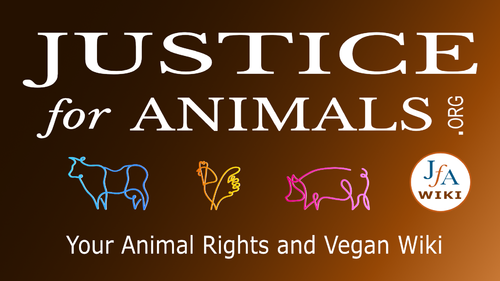Glf:Sandbox for Image and TOC

Context
People are becoming increasingly concerned about the welfare of animals used for food. This concern is spawned by undercover videos, social-media postings, documentary movies, and reporting by the press.
Some people hope to act on that concern by buying products that bear one of the humane-certification labels or that brandish some other designation, such as cage free, free-range, grass fed, or organic, thinking that such purchases cause little or no harm to the individuals whose flesh and secretions have been packaged for sale.
First, we explain why—even if specific humane claims are true—using animals for food is still not humane. Because using animals for food is still not humane, it's not necessary to show that the humane-sounding labels and certifications are misleading. But we do so anyway just so there can be no doubt. We also reveal that cruel practices are systemic to the process of using animals for food.
After the evidence is presented, it's easy to conclude that these labels have little to do with the well-being of the animals but are designed to at once assuage our guilt and compel us to spend more.
Talking Points
Animals are harmed by depriving them of their lives.
Research by cognitive ethologists and neurobiologists has confirmed that the animals we exploit for food, including fish, have desires, preferences, and emotions. They have a sense of themselves, a sense of the future, and a will to live. They have families, social communities, and natural behaviors.[1]
In these ways and others, they are like us, and what happens to them matters to them. They each have an inherent value apart from their usefulness to us. So even if humane-sounding labels were aboveboard, using animals for food is still not humane because we are depriving them of the only life they have and a life they value.
This is true no matter how the killing is done, and it is true not only for animals used for meat but also for animals used for dairy products and eggs. Those used for dairy and eggs, like those used for meat, are slaughtered very early in their lives. They are slaughtered when their reproductive systems are used up and they are no longer profitable. None of the animals we use for food are allowed to live out their lives.
Taking the life of anyone who wants to live is to harm that individual, regardless of their species. Just as we would not consider killing for food humane if it were done to dogs, cats, or humans, then by any measure of fairness and justice, it is not humane when done to other sentient beings.
Research by cognitive ethologists and neurobiologists has confirmed that the animals we exploit for food, including fish, have desires, preferences, and emotions. They have a sense of themselves, a sense of the future, and a will to live. They have families, social communities, and natural behaviors.[2] Research by cognitive ethologists and neurobiologists has confirmed that the animals we exploit for food, including fish, have desires, preferences, and emotions. They have a sense of themselves, a sense of the future, and a will to live. They have families, social communities, and natural behaviors.[3]
Research by cognitive ethologists and neurobiologists has confirmed that the animals we exploit for food, including fish, have desires, preferences, and emotions. They have a sense of themselves, a sense of the future, and a will to live. They have families, social communities, and natural behaviors.[4]
Research by cognitive ethologists and neurobiologists has confirmed that the animals we exploit for food, including fish, have desires, preferences, and emotions. They have a sense of themselves, a sense of the future, and a will to live. They have families, social communities, and natural behaviors.[5]
Research by cognitive ethologists and neurobiologists has confirmed that the animals we exploit for food, including fish, have desires, preferences, and emotions. They have a sense of themselves, a sense of the future, and a will to live. They have families, social communities, and natural behaviors.[6]
Humane slaughter is an oxymoron. Humane means showing compassion or benevolence. To slaughter is to kill or butcher someone who does not want to die. Slaughter is a violent act, not an act of compassion or benevolence.
Humane-sounding labels and certifications are mostly meaningless.
Here we address the most common labels and certifications. Some labels and certifications cover some forms of abuse, and others cover different forms of abuse, but none address all forms of abuse. But even if they did, the standards are often not enforced.
- ↑ Bekoff, Mark, Colin Allen, and Gordon Burghardt. The Cognitive Animal: Empirical and Theoretical Perspectives on Animal Cognition. A Bradford Book, 2002
- ↑ Bekoff, Mark, Colin Allen, and Gordon Burghardt. The Cognitive Animal: Empirical and Theoretical Perspectives on Animal Cognition. A Bradford Book, 2002
- ↑ Bekoff, Mark, Colin Allen, and Gordon Burghardt. The Cognitive Animal: Empirical and Theoretical Perspectives on Animal Cognition. A Bradford Book, 2002
- ↑ Bekoff, Mark, Colin Allen, and Gordon Burghardt. The Cognitive Animal: Empirical and Theoretical Perspectives on Animal Cognition. A Bradford Book, 2002
- ↑ Bekoff, Mark, Colin Allen, and Gordon Burghardt. The Cognitive Animal: Empirical and Theoretical Perspectives on Animal Cognition. A Bradford Book, 2002
- ↑ Bekoff, Mark, Colin Allen, and Gordon Burghardt. The Cognitive Animal: Empirical and Theoretical Perspectives on Animal Cognition. A Bradford Book, 2002